Abstract
This study investigated the physiological mechanisms of resistance to chloramines developed by Klebsiella pneumoniae grown in a nutrient-limited environment. Growth under these conditions resulted in cells that were smaller than cells grown under high-nutrient conditions and extensively aggregated. Cellular aggregates ranged from 10 to more than 10,000 cells per aggregate, with a mean population aggregate size of 90 cells. This aggregation may have been facilitated by the presence of extracellular polymer material. By using glucose as a reference of capsule content, it was determined that growth under low-nutrient conditions produced cells with 8 x 10(-14) to 41 x 10(-14) g of carbohydrate per cell, with a mean +/- standard deviation of 27 x 10(-14) +/- 16 x 10(-14) g of carbohydrate per cell. In comparison, growth under high-nutrient conditions resulted in 2.7 x 10(-14) to 5.9 x 10(-14) g of carbohydrate per cell, with a mean and standard deviation of 4.3 x 10(-14) +/- 1.2 x 10(-14) g of carbohydrate per cell. Cell wall and cell membrane lipids also varied with growth conditions. The ratio of saturated to unsaturated fatty acids in cells grown under low-nutrient conditions was approximately five times greater than that in cells grown under high-nutrient conditions, suggesting possible differences in membrane permeability. An analysis of sulfhydryl (-SH) groups revealed no quantitative difference with respect to growth conditions. However, upon exposure to chloramines, only 33% of the -SH groups of cells grown under low-nutrient conditions were oxidized, compared with 80% oxidization of -SH groups in cells grown under high-nutrient conditions. The reduced effectiveness of chloramine oxidization of -SH groups in cells grown under low-nutrient conditions may be due to restricted penetration of chloramines into the cells, conformational changes of enzymes, or a combination of both factors. The results of this study suggest that chloramine resistance developed under low-nutrient growth conditions may be a function of multiple physiological factors, including cellular aggregation and protection of sulfhydryl groups within the cell.
Full text
PDF

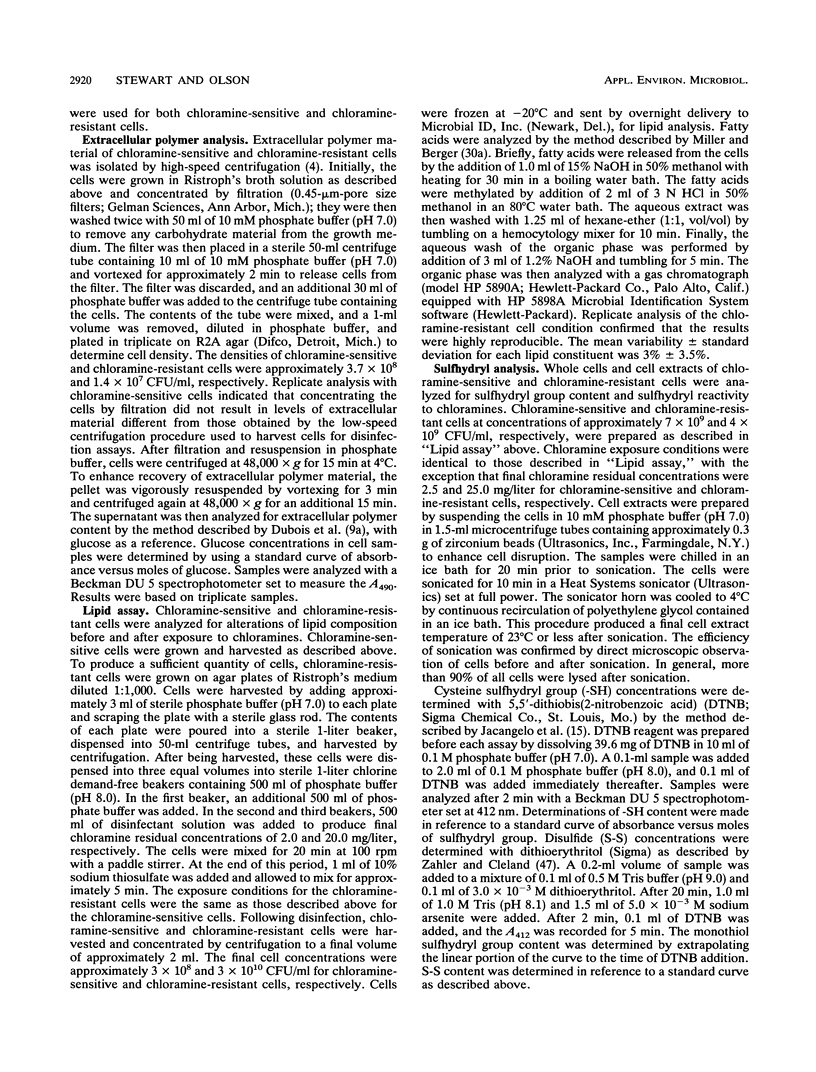
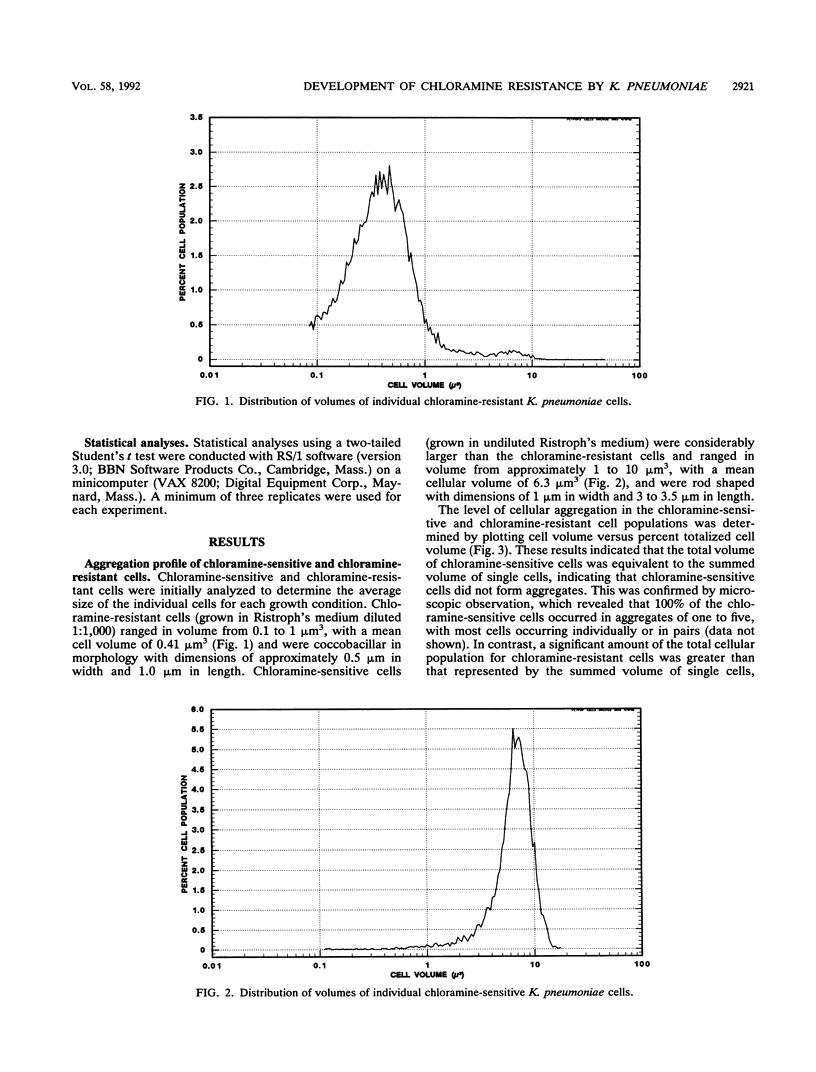

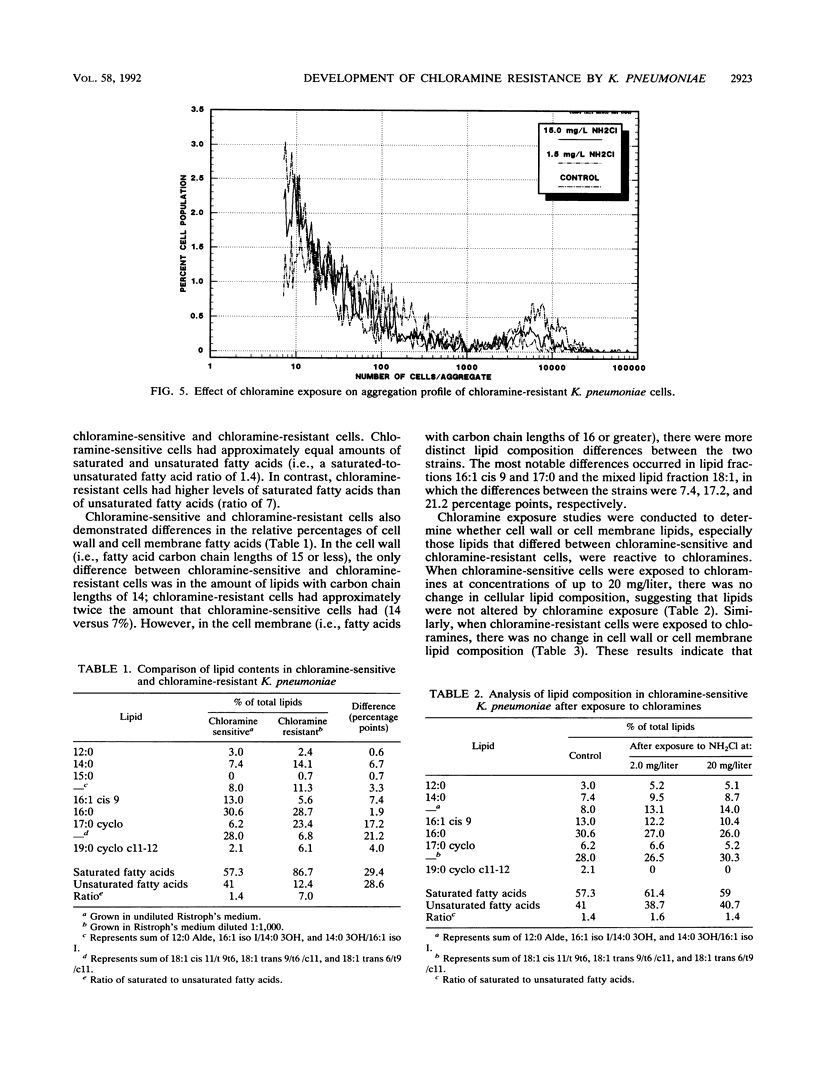
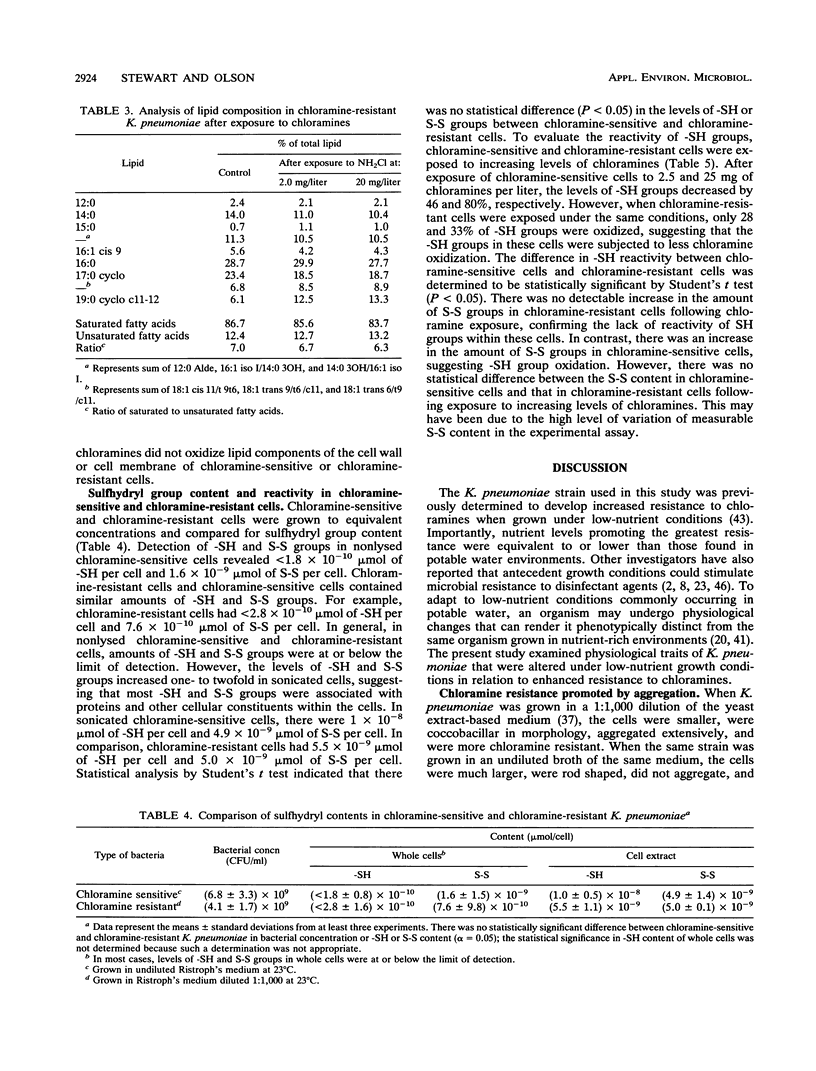
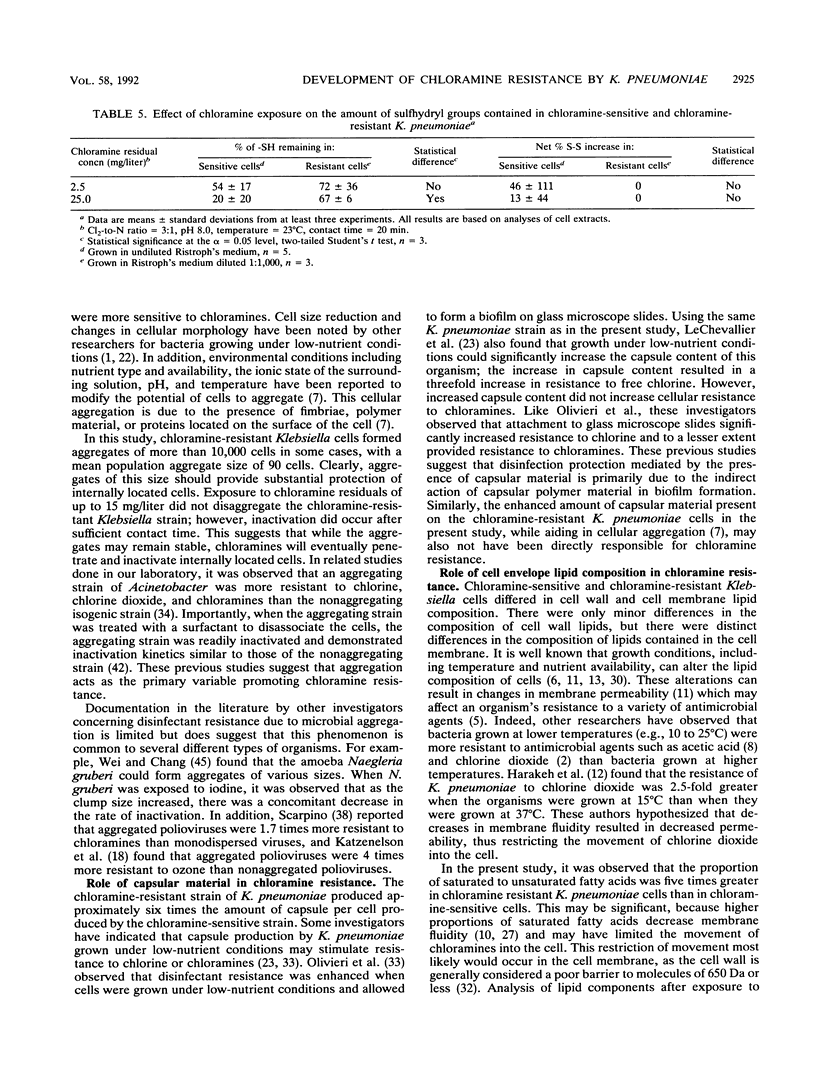
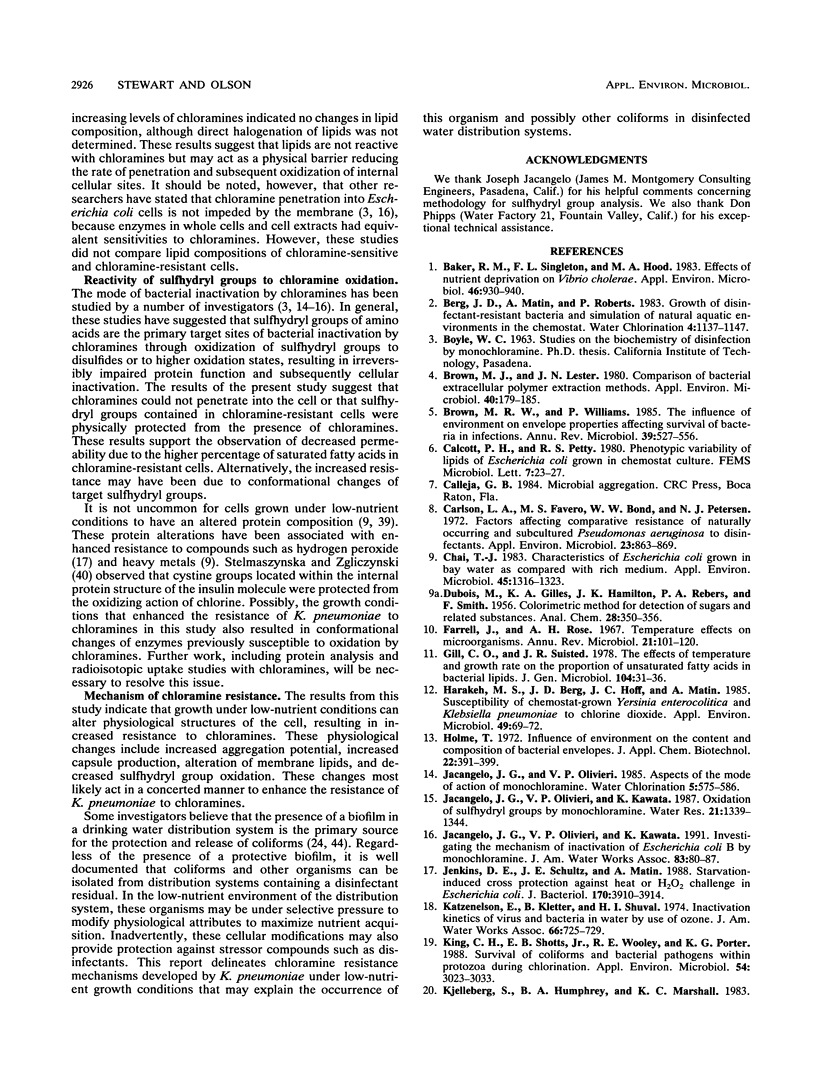
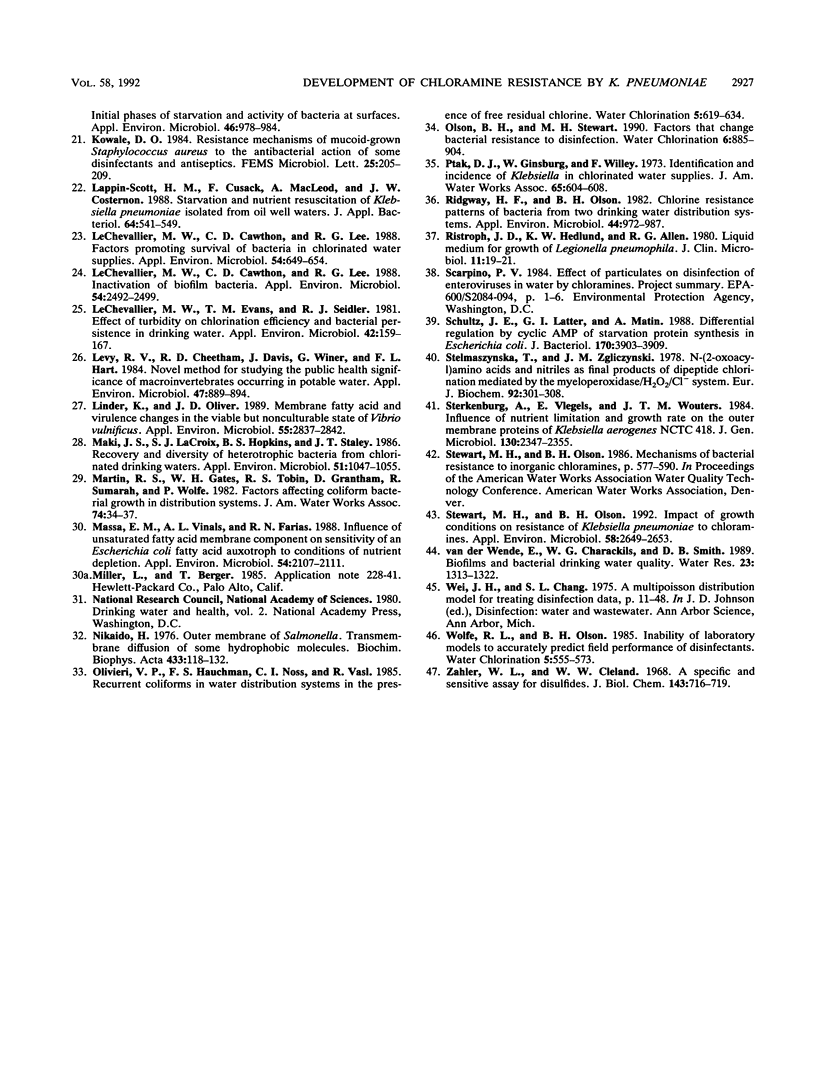
Selected References
These references are in PubMed. This may not be the complete list of references from this article.
- Baker R. M., Singleton F. L., Hood M. A. Effects of nutrient deprivation on Vibrio cholerae. Appl Environ Microbiol. 1983 Oct;46(4):930–940. doi: 10.1128/aem.46.4.930-940.1983. [DOI] [PMC free article] [PubMed] [Google Scholar]
- Brown M. J., Lester J. N. Comparison of bacterial extracellular polymer extraction methods. Appl Environ Microbiol. 1980 Aug;40(2):179–185. doi: 10.1128/aem.40.2.179-185.1980. [DOI] [PMC free article] [PubMed] [Google Scholar]
- Brown M. R., Williams P. The influence of environment on envelope properties affecting survival of bacteria in infections. Annu Rev Microbiol. 1985;39:527–556. doi: 10.1146/annurev.mi.39.100185.002523. [DOI] [PubMed] [Google Scholar]
- Carson L. A., Favero M. S., Bond W. W., Petersen N. J. Factors affecting comparative resistance of naturally occurring and subcultured Pseudomonas aeruginosa to disinfectants. Appl Microbiol. 1972 May;23(5):863–869. doi: 10.1128/am.23.5.863-869.1972. [DOI] [PMC free article] [PubMed] [Google Scholar]
- Chai T. J. Characteristics of Escherichia coli grown in bay water as compared with rich medium. Appl Environ Microbiol. 1983 Apr;45(4):1316–1323. doi: 10.1128/aem.45.4.1316-1323.1983. [DOI] [PMC free article] [PubMed] [Google Scholar]
- Farrell J., Rose A. Temperature effects on microorganisms. Annu Rev Microbiol. 1967;21:101–120. doi: 10.1146/annurev.mi.21.100167.000533. [DOI] [PubMed] [Google Scholar]
- Gill C. O., Suisted J. R. The effects of temperature and growth rate on the proportion of unsaturated fatty acids in bacterial lipids. J Gen Microbiol. 1978 Jan;104(1):31–36. doi: 10.1099/00221287-104-1-31. [DOI] [PubMed] [Google Scholar]
- Harakeh M. S., Berg J. D., Hoff J. C., Matin A. Susceptibility of chemostat-grown Yersinia enterocolitica and Klebsiella pneumoniae to chlorine dioxide. Appl Environ Microbiol. 1985 Jan;49(1):69–72. doi: 10.1128/aem.49.1.69-72.1985. [DOI] [PMC free article] [PubMed] [Google Scholar]
- Jenkins D. E., Schultz J. E., Matin A. Starvation-induced cross protection against heat or H2O2 challenge in Escherichia coli. J Bacteriol. 1988 Sep;170(9):3910–3914. doi: 10.1128/jb.170.9.3910-3914.1988. [DOI] [PMC free article] [PubMed] [Google Scholar]
- King C. H., Shotts E. B., Jr, Wooley R. E., Porter K. G. Survival of coliforms and bacterial pathogens within protozoa during chlorination. Appl Environ Microbiol. 1988 Dec;54(12):3023–3033. doi: 10.1128/aem.54.12.3023-3033.1988. [DOI] [PMC free article] [PubMed] [Google Scholar]
- Kjelleberg S., Humphrey B. A., Marshall K. C. Initial phases of starvation and activity of bacteria at surfaces. Appl Environ Microbiol. 1983 Nov;46(5):978–984. doi: 10.1128/aem.46.5.978-984.1983. [DOI] [PMC free article] [PubMed] [Google Scholar]
- Lappin-Scott H. M., Cusack F., MacLeod A., Costerton J. W. Starvation and nutrient resuscitation of Klebsiella pneumoniae isolated from oil well waters. J Appl Bacteriol. 1988 Jun;64(6):541–549. doi: 10.1111/j.1365-2672.1988.tb02445.x. [DOI] [PubMed] [Google Scholar]
- LeChevallier M. W., Cawthon C. D., Lee R. G. Factors promoting survival of bacteria in chlorinated water supplies. Appl Environ Microbiol. 1988 Mar;54(3):649–654. doi: 10.1128/aem.54.3.649-654.1988. [DOI] [PMC free article] [PubMed] [Google Scholar]
- LeChevallier M. W., Cawthon C. D., Lee R. G. Inactivation of biofilm bacteria. Appl Environ Microbiol. 1988 Oct;54(10):2492–2499. doi: 10.1128/aem.54.10.2492-2499.1988. [DOI] [PMC free article] [PubMed] [Google Scholar]
- LeChevallier M. W., Evans T. M., Seidler R. J. Effect of turbidity on chlorination efficiency and bacterial persistence in drinking water. Appl Environ Microbiol. 1981 Jul;42(1):159–167. doi: 10.1128/aem.42.1.159-167.1981. [DOI] [PMC free article] [PubMed] [Google Scholar]
- Levy R. V., Cheetham R. D., Davis J., Winer G., Hart F. L. Novel method for studying the public health significance of macroinvertebrates occurring in potable water. Appl Environ Microbiol. 1984 May;47(5):889–894. doi: 10.1128/aem.47.5.889-894.1984. [DOI] [PMC free article] [PubMed] [Google Scholar]
- Linder K., Oliver J. D. Membrane fatty acid and virulence changes in the viable but nonculturable state of Vibrio vulnificus. Appl Environ Microbiol. 1989 Nov;55(11):2837–2842. doi: 10.1128/aem.55.11.2837-2842.1989. [DOI] [PMC free article] [PubMed] [Google Scholar]
- Maki J. S., LaCroix S. J., Hopkins B. S., Staley J. T. Recovery and diversity of heterotrophic bacteria from chlorinated drinking waters. Appl Environ Microbiol. 1986 May;51(5):1047–1055. doi: 10.1128/aem.51.5.1047-1055.1986. [DOI] [PMC free article] [PubMed] [Google Scholar]
- Massa E. M., López Vińals A., Farías R. N. Influence of unsaturated fatty acid membrane component on sensitivity of an Escherichia coli fatty acid auxotroph to conditions of nutrient depletion. Appl Environ Microbiol. 1988 Aug;54(8):2107–2111. doi: 10.1128/aem.54.8.2107-2111.1988. [DOI] [PMC free article] [PubMed] [Google Scholar]
- Nikaido H. Outer membrane of Salmonella typhimurium. Transmembrane diffusion of some hydrophobic substances. Biochim Biophys Acta. 1976 Apr 16;433(1):118–132. doi: 10.1016/0005-2736(76)90182-6. [DOI] [PubMed] [Google Scholar]
- Ridgway H. F., Olson B. H. Chlorine resistance patterns of bacteria from two drinking water distribution systems. Appl Environ Microbiol. 1982 Oct;44(4):972–987. doi: 10.1128/aem.44.4.972-987.1982. [DOI] [PMC free article] [PubMed] [Google Scholar]
- Ristroph J. D., Hedlund K. W., Allen R. G. Liquid medium for growth of Legionella pneumophila. J Clin Microbiol. 1980 Jan;11(1):19–21. doi: 10.1128/jcm.11.1.19-21.1980. [DOI] [PMC free article] [PubMed] [Google Scholar]
- Schultz J. E., Latter G. I., Matin A. Differential regulation by cyclic AMP of starvation protein synthesis in Escherichia coli. J Bacteriol. 1988 Sep;170(9):3903–3909. doi: 10.1128/jb.170.9.3903-3909.1988. [DOI] [PMC free article] [PubMed] [Google Scholar]
- Stelmaszyńska T., Zgliczynski J. M. N-(2-Oxoacyl)amino acids and nitriles as final products of dipeptide chlorination mediated by the myeloperoxidase/H2O2/Cl- system. Eur J Biochem. 1978 Dec 1;92(1):301–308. doi: 10.1111/j.1432-1033.1978.tb12748.x. [DOI] [PubMed] [Google Scholar]
- Sterkenburg A., Vlegels E., Wouters J. T. Influence of nutrient limitation and growth rate on the outer membrane proteins of Klebsiella aerogenes NCTC 418. J Gen Microbiol. 1984 Sep;130(9):2347–2355. doi: 10.1099/00221287-130-9-2347. [DOI] [PubMed] [Google Scholar]
- Stewart M. H., Olson B. H. Impact of growth conditions on resistance of Klebsiella pneumoniae to chloramines. Appl Environ Microbiol. 1992 Aug;58(8):2649–2653. doi: 10.1128/aem.58.8.2649-2653.1992. [DOI] [PMC free article] [PubMed] [Google Scholar]
- Zahler W. L., Cleland W. W. A specific and sensitive assay for disulfides. J Biol Chem. 1968 Feb 25;243(4):716–719. [PubMed] [Google Scholar]


